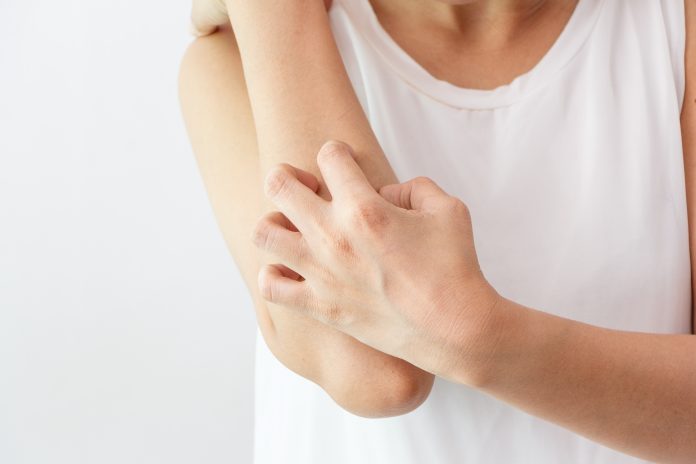Both heat rash and hives are linked to hot temperatures and humid environments; therefore, they commonly occur in children and babies in the summer months.
Parents may come to the pharmacy for advice to prevent heat rash and hives or to soothe their child’s skin. Both can be managed and controlled.
Heat rash
Heat rash, also known as miliaria, refers to a group of skin conditions that are caused by blockage of the sweat ducts.
Miliaria is very common in babies and occurs in 15 per cent of newborns as their sweat ducts are not fully developed. Heat rash is caused when the sweat ducts are blocked, commonly from excess sweating and high temperatures.1
Heat rash appears like small blisters or spots and is often very itchy. The rash can be red or pink in children with lighter skin, while in children with darker skin, the rash can appear purple or grey. If blisters are filled with pus or the inflammation lasts more than three days, children and babies should be taken to the GP.
Heat rash usually disappears when the body is cooled down; therefore, using air-conditioning, dressing the baby in loose clothing, avoiding too many layers, removing sweaty or wet nappies regularly, and drying out the baby’s skin folds after bathing can help to prevent heat rash from occurring.2
Health Direct states that heat rash can be treated in children and newborns by cooling the skin with a lukewarm bath and cold compress. To prevent scratching, apply a calamine lotion or corticosteroid cream to soothe the itchy skin and avoid damage to the skin.3
Hives
Hives, also known as Urticaria, is a common skin condition that causes an itchy rash; it can be smooth or raised. The rash can be very itchy but usually subsides within twenty-four hours.4
If hives occur most days for more than six weeks, this is defined as chronic urticaria, and a specialist should be consulted, such as a doctor or dermatologist. 5
The Raising Children Network provides hives that can be relieved by:
- Applying a cold compress
- Giving the child a cool bath or shower
- Using a fan to blow on the skin
- Applying calamine lotion to the hives and letting it dry.
To prevent hives, taking a non-drowsy antihistamine can be used from six months of age. If the child is under two, a non-drowsy antihistamine must be used.6
NPS MedicineWise affirms that sedating antihistamines have little role in therapeutics and that non-drowsy antihistamines have become the primary treatment option.
NPS MedicineWise also provides that antihistamines are most effective when dosed twice a day to prevent the onset of hives rather than treat them as they appear.7
Hives can be a sign of an allergic reaction. According to the Royal Children’s Hospital Melbourne, hives are usually harmless; however, symptoms of anaphylaxis should be looked out for.
If the child has hives accompanied by any of the following symptoms, an ambulance should be called immediately:
- difficulty breathing
- wheeze or persistent cough
- swelling of the tongue
- swelling or tightness in the throat
- difficulty talking or a hoarse voice
- loss of consciousness of, collapse or becoming pale and floppy.8
References:
- The Australasian College of Dermatologists. ‘Miliaria’. 2015. <dermcoll.edu.au/atoz/miliaria/> [accessed: 15.12.2022].
- Raising Children Network. Heat Rash. 2021. <raisingchildren.net.au/guides/a-z-health-reference/heat-rash#:~:text=Heat%20rash%20or%20prickly%20heat%20looks%20like%20little%20spots%20or,last%20more%20than%203%20days> [accessed: 15.12.2022].
- Health Direct. ‘Heat Rash’. 2021. <healthdirect.gov.au/heat-rash#treat-children> [accessed: 5.12.2022].
- The Australasian College of Dermatologists. ‘Urticaria’. 2019. <dermcoll.edu.au/atoz/urticaria/> [accessed: 29.11.2022].
- Australasian Society of Clinical Immunology and Allergy. ‘Hives (Urticaria) <allergy.org.au/patients/skin-allergy/urticaria-hives> [accessed: 29.11.2022].
- Raising Children Network. ‘Hives’. 2021. <raisingchildren.net.au/guides/a-z-health-reference/hives> [accessed: 15.12.2022].
- NPS Medicinewise. ‘Antihistamine and Allergy’. 2018. <nps.org.au/australian-prescriber/articles/antihistamines-and-allergy>[accessed: 15.12.2022].
- The Royal Children’s Hospital Melbourne. ‘Hives’. 2021. <rch.org.au/kidsinfo/fact_sheets/Hives/> [accessed: 29.11.2022].
This feature was originally published in the February issue of Retail Pharmacy magazine.




